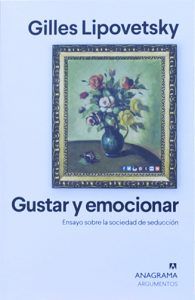

Gustar y emocionar. Ensayo sobre la sociedad de la seducción, by Giles Lipovetsky
A fundamental text for understanding how to manage a key need in strategy and innovation.

|
No. of pages:
|
470 |
| Publisher: | Anagrama (Argumentos) |
| Language: | Castellano |
| ISBN: | 9788433964601 |
| Year of release: | 2020 |
| Year of original publication: | 2017 |
| Place of publication | Barcelona |
| Where to buy: | Amazon |
In two sentences:
"All societies have developed resources that enable the power of attraction of beings to be increased" "After film and recorded music, it is up to marketing, advertising and branding to focus their attention on the affective dimension"
In 500 characters:
The role of seduction in defining and operating today’s society is key, as it is present in all spheres and is an essential strategy for building and maintaining interest in our brands and proposals.
Acts such as courting, flirting and casual encounters are emboldened by quasi-universal codes and are amplified through adornments and expressions that no longer happen only between people, but also between brands and people.
Why I should read it:
Since the publication of The Empire of the Ephemeral (1987), has been exploring the importance of fashion, trends and all the expressions that surround them in an entertaining and somewhat naïf manner.
Alongside Bauman, is the most frequently cited sociologist in essays on the effect that fashion and trends have on society.
Unlike other authors, Lipovetsky is excellent at spreading his message, meaning the text is easy to read and follow, is full of inspiring examples and speaks of emotions and need states from a unique and fruitful perspective for strategists and innovators.
Readers should not forget that Lipovetsky is a sociologist and not a marketing expert. He uses concepts that have other meanings in the marketing world. It is important not to lose sight of the fact that his viewpoint is that of a social analyst, not that of a manager/creator of brands and messages.
10 inspiring pieces of content:
- The author likens seduction to a “theatrical game whose actors try to appear advantaged in order to attract the interest and desire of the other”, whereby deception (adornments, dress, speech, presentation, etc.) is key. Tattoos, makeup, materials and colours are key to seduction: throughout history there has never been a “theatre of seduction without a body modified through deception”.
- Today’s society has broken with the codes, rituals and restrictions of seduction, which has also lost its negative/dangerous/tempting connotation and has ceased to be controlled by institutions (family, society, Church). At this juncture, it has become a sales strategy.
- Seduction is omnipresent, and the author links it to the market society and the constant need to seduce and be seduced. Our everyday life is full of “attractive” offers, “tempting” products, “seductive” experiences and “pleasurable” content.
- What is seductive extends from the private to the public, the political and the educational: everything has to be seductive, attractive, captivating and entertaining, from a political rally to a university class. The codes of seduction can lose their erotic or sexual component and can be applied in any environment where actors want to persuade or transmit something.
- Brands create seduction through a narrative and sell the seduction process. Courtship, intentions, moments and promises are the keys to seduction. There is rarely consummation, as it defeats the purpose of seduction.
- The way we build relationships through social networks allows us to sell the illusion of an infinite succession of encounters freed from social traditions and conventions.
- The text offers an inspiring chronology and mapping of concepts such as casual encounters, flirtation and the role of fashion, makeup, phrases and situations. While it may appear obsolete to contemporary eyes, it is a very rich source of strategic inspiration.
- Today we are witnessing how seduction inhabits what is politically incorrect. The use of provocations, false statements, insults and vulgarities — it now works as a way to convince and seduce empathetically those who feel abandoned, forgotten or failed by their environment.
- Brands take advantage of seduction by cultivating a relentless stimulation of desires. The author, who is very critical of marketing, connects the use of seduction to what he sees as “the social manufacture of needs”.
- The text ends with a look at the future of the ubiquitous society of seduction, which is threatened on five fronts: environmental challenges, the economic situation, new political demonstrations, the proliferation of surveillance techniques and the evolution of rational thinking, culture and spirit.
If you are interested in this text, you might also like:
- The Empire of the Ephemeral, Gilles Lipovetsky
- The Painter of Modern Life, Charles Baudelaire